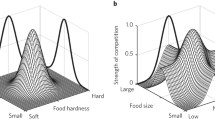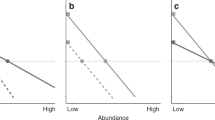Summary
The linearity assumption in the logistic model of population growth is violated for nearly all organisms. Two simple models, the θ-logistic and the θ-Ricker, are shown to account for asymmetric patterns of population growth for 27 species of Drosophila and for a variety of other organisms, where the data were derived from the literature. These models are developed so as to aid laboratory and field ecologists to anticipate the dynamics of various experimental organisms. Potential problems of data gathering and model applications for experimental ecologists and wild life management biologists are identified. Intraspecific asymmetries offer alternative explanations to the “habitat selection” model, and the “higher order interactions” or coalitions model, for interspecific competition.
Similar content being viewed by others
References
Ayala FJ (1969) Experimental invalidation of the principle of competitive exclusion. Nature 224:1076–1079
Ayala FJ, Gilpin ME, Ehrenfeld JG (1973) Competition between species: Theoretical models and experimental tests. Theor Pop Biol 4:331–356
Bodenheimer FS (1937) Studies in animal populations. II. Seasonal population trends of the honey bee. Quart Rev Biol 12:406–425
Brenchley GA (1979) Community matrix models: Inconsistent results using Vandermeer's data. Amer Natur 113:456–459
Butlin NG (1962) Distribution of the sheep population: Preliminary statistical picture, 1860–1957. In: The simple fleece, studies in the Australian wool industry, (A Barnard, ed.), p 281–307. Parkville N2, Victoria, Australia: Melbourne Univ Press
Chapman RN (1928) The quantitative analysis of environmental factors. Ecology 9:111–122
Clark CW (1976) Mathematical bioeconomics: The optimal management of renewable resources, 352 pp. New York: John Wiley & Sons
Crowcroft P, Rowe FP (1957) The growth of confined colonies of the wild house-mouse (Mus musculus L.). Proc Zool Soc Lond 129:359–370
Davidson J (1938a) On the ecology of the growth of the sheep population in South Australia. Trans Roy Soc South Australia 62:141–148
Davidson J (1938b) On the growth of the sheep population in Tasmania. Trans Roy Soc South Australia 62:342–346
Donald C (1961) Competition for light in crops and pastures. In: Mechanisms in biological competition, (FL Milthrope, ed), pp 282–313. Cambridge: University Press
Einarsen AS (1942) Specific results from ring-necked pheasant studies in the Pacific Northwest. Trans Seventh North Amer Wildl Conf 7:130–146
Einarsen AS (1945) Some factors affecting ring-necked pheasant population density. The Murrelet 26:39–44
Fletcher RI (1978) On the restructuring of the Pella-Tomlinson system. Fish Bull US 76:515–521
Fox WW Jr (1970) An exponential surplus-yield model for optimizing exploited fish populations. Trans American Fisheries Soc 99:80–88
Futuyma DJ (1979) Evolutionary biology, 565 pp. Sunderland, Mass: Sinauer Assoc
Gause GF (1934) The struggle for existence, 163 pp. New York: Dover Publ (1971)
Gilbert N, Gutierrez AP, Frazer BD, Jones RE (1976) Ecological relationships, 157 pp. Reading and San Francisco: WH Freeman
Gilpin ME, Ayala FJ (1973) Global models of growth and competition. Proc Natl Acad Sci USA 70:3590–3593
Gilpin ME, Case TJ, Ayala FJ (1976) θ-selection. Math Biosci 32:131–139
Gilpin ME, Justice KE (1972) Reinterpretation of the invalidation of the principle of competitive exclusion. Nature 236:273–301
Hassell MP, Lawton JH, May RM (1976) Patterns of dynamical behavior in single species populations. J Anim Ecol 45:471–486
Holdaway FG (1932) An experimental study of the growth of populations of the “flour beetle” Tribolium confusum Duval, as affected by atmospheric moisture. Ecol Monogr 2:261–304
Hudson R (1965) The spread of the collared dove in Britain and Ireland. British Birds 58:105–139
Hudson R (1972) Collared doves in Britain and Ireland during 1965–1970. British Birds 65:139–155
Lotka AJ (1956) Elements of mathematical biology, 465 pp. New York: Dover Publ
May RM, Oster GF (1976) Bifurcation and dynamic complexity in simple ecological models. Amer Natur 110:573–599
McNaughton SJ, Wolf LL (1978) General ecology, Holt, Rinehart and Winston, New York pp 702
M'Kendrick AG, Kesava Pai M (1911) The rate of multiplication of microorganisms: A mathematical study. Proc Roy Soc Edinb 31:649–655
Moule GR (1962) The ecology of sheep in Australia. In: The simple fleece, studies in the Australian wool industry A Barnard (ed), Parkville N2, Victoria, Australia: Melburne Univ Press p 82–105
Neill WE (1974) The community matrix and interdependence of the competition coefficients. Amer Natur 108:399–408
Palmblad IG (1968) Competition in experimental populations of weeds with emphasis on the regulation of population size. Ecology 49:26–34
Pearl R, Parker SL (1922) On the influence of population upon the rate of reproduction in Drosophila. Proc Natl Acad Sci USA 8:212–219
Pearl R (1925) The biology of population growth, Alfred A Knopf, New York p 260
Pella JJ, Tomlinson PK (1969) A generalized stock production model. Inter-American Tropical Tuna Commission Bull. 13:419–496
Pianka ER (1976) Competition and niche theory. In: Theoretical ecology R May (ed), Philadelphia: WB Saunders p 114–141
Pomerantz MJ (1981) Do “higher order interactions” in competition systems really exist? Amer Natur (in press)
Pomerantz MJ (1979) Investigations in intra- and interspecific competition. Ph D Dissertation, Univ of California, San Diego, La Jolla
Pratt DM (1943) Analysis of population development in Daphnia at different temperatures. Biol Bull 85:116–140
Richards FJ (1959) A flexible growth function for empirical use. J Exp Bot 10:290–300
Ricker WE (1954) Stock and recruitment. J Fish Resources Brd Canada 11:559–623
Ricker WE (1958) Handbook of computations for biological statistics of fish populations. Bull Fish Res Brd Canada 117:300
Rosenzweig ML (1979) Optimal habitat selection in two-species competitive systems. In: Population ecology, Fortschr Zool 25:2/3 U Halbach and J Jacobs (eds), Gustav Fischer Verlag, Stuttgart, New York: pp 283–293
Schaefer MB (1954) Some aspects of the dynamics of populations important to the management of the commercial marine fisheries. Inter-American Tropical Tuna Commission Bull 1:25–56
Schaefer MB, Beverton RJH (1963) Fishery dynamics — their analysis and interpretation. In: The sea — ideas and observations on progress in the study of the seas. Vol 2, The composition of sea-water, comparative and descriptive oceanography M Hill (ed) Interscience, New York p 464–483
Schoener TW (1973) Population growth regulated by intraspecific competition for energy or time: Some simple representations. Theor Pop Biol 4:56–84
Schroeder GD, Rosenzweig ML (1975) Perturbation analysis of competition and overlap in habitat utilization between Dipodomys ordii and Dipodomys merriami. Oecologia (Berl) 19:9–28
Silliman RP, Gutsell JS (1958) Experimental exploitation of fish populations. Fish Bull, US Fish and Wildl Serv 58:215–252
Smith FE (1954) Quantitative aspects of population growth. In: Dynamics of growth processes E Boell (ed), Princeton Univ Press, Princeton, New Jersey p 277–294
Smith FE (1963) Population dynamics in Daphnia magna and a new model for population growth. Ecology 44:651–663
Strickberger MW (1962) Experiments in genetics with Drosophila. 144 pp. New York: John Wiley & Sons
Terao A, Tanaka T (1928) Population growth of the water-flea, Moina macrocapa Strauss. Proc Imper Acad (Japan) 4:550–552
Thomas WR, Pomerantz MJ (1981) Feasibility and stability in community dynamics. Amer Natur (in press)
Thomas WR, Pomerantz MJ, Gilpin ME (1980) Chaos, asymmetric growth and group selection for dynamical stability. Ecology (in press)
Vandermeer JH (1969) The competitive structure of communities: An experimental approach with protozoa. Ecology 50:362–371
Varley GC, Gradwell GR, Hassell MP (1974) Insect population ecology: An analytical approach, University of California Press, Berkeley and Los Angeles pp 212
Verhulst PF (1838) Notice sur la loi que la population suit dans son accroissement. Corr. Math. et Phys. 10:113–121. Reprinted in: Readings in ecology (E Kormandy, ed) Englewood Cliffs, New Jersey: Prentice-Hall (1965)
Wilbur HM (1972) Competition, predation, and the structure of the Ambystoma-Rana sylvatica community. Ecology 53:3–21
Author information
Authors and Affiliations
Rights and permissions
About this article
Cite this article
Pomerantz, M.J., Thomas, W.R. & Gilpin, M.E. Asymmetries in population growth regulated by intraspecific competition: Empirical studies and model tests. Oecologia 47, 311–322 (1980). https://doi.org/10.1007/BF00398523
Received:
Issue Date:
DOI: https://doi.org/10.1007/BF00398523




